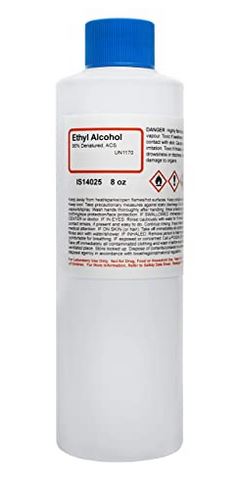ETHANOL, denaturated, 95%, 1 l, bot.
Valid Article
ETHANOL, denaturated, 95%
Definition
Alcohol used to prepare certain reagents such as:
- Differentiator (in the Gram staining)
- Acid alcohol (in Ziehl-Neelsen staining)
Synonym
95% denatured ethyl alcohol
Specifications
Technical specifications
- CAS n°: 64-17-5
- Formula: C2H6O (C2H5OH)
- Liquid reagent
- Quality: denatured
- Concentration: at least 95%
Packaging & Labelling
1 or 5 litre glass or plastic bottle
Transport Dangerous Goods
- UN1170
- Class: 3
- Packing group: II
- Proper shipping name: Ethanol solution (ethyl alcohol)
Instructions for use
Check the import conditions of products containing alcohol.
70 % ethanol can be used for the antisepsis of intact skin prior to injections.
Please consult the “Updated laboratory procedures, 2022” or “Bacteriology laboratory procedures and resources“ available online via the Laboratory working Group sharepoint page: Laboratory Procedures and Resources.
https://msfintl.sharepoint.com/sites/msfintlcommunities/LabWG/SitePages/Home.aspx
For offline access, contact your laboratory advisor.
Storage
- In a hermetically sealed container, upright, on the bottom shelves
- No expiry date
Waste management
Substance with hazardous characteristics. Please contact your watsan referent for advice on proper disposal.
Detailed hazard and precautionary information can be found in the safety data sheet (SDS).
Classification EC Regulation N° 1272/2008
- Flammable liquids: Category 2, H225
- Eye irritation: Category 2, H319
Signal Word
Danger
| H225 | Highly flammable liquid and vapour |
| H319 | Causes serious eye irritation |
| P403 + P235 | Store in a well-ventilated place. Keep cool. |
| P210 | Keep away from heat/sparks/open flames/hot surfaces. – No smoking. |
| P280 | Wear protective gloves/protective clothing/eye protection/face protection |
| P305 + P351 + P338 | IF IN EYES: rinse cautiously with water for several minutes. If the victim wears contact lenses, remove them if possible. Keep rinsing |
| P337 + P313 | If eye irritation persists: get medical advice/attention |
MSF requirements
Stainings do not need pure alcohol.
The choice of "denatured" quality aims to prevent any theft for local consumption.


![[KMEDMBLB02D] (bacteriology Mini-Lab) STARTERKIT, 800 samples, RTR](/web/image/product.template/579047/image_256/%5BKMEDMBLB02D%5D%20%28bacteriology%20Mini-Lab%29%20STARTERKIT%2C%20800%20samples%2C%20RTR?unique=5fd330d)
![[KMEDMLAB103] (laboratory mod) TUBERCULOSIS REAGENTS ZN, 1000 tests, RTR](/web/image/product.template/573225/image_256/%5BKMEDMLAB103%5D%20%28laboratory%20mod%29%20TUBERCULOSIS%20REAGENTS%20ZN%2C%201000%20tests%2C%20RTR?unique=628ab1f)